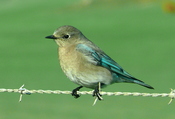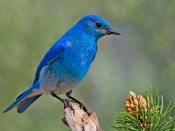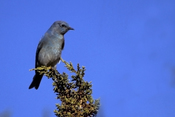The Mountain Bluebird is the only bird in the Bluebird family that is most entirely blue. The male is turquoise-blue on top and as it gets lower the color fades into white. The female bluebird is dull brownish with a touch of blue on the rump, tail and wings, she is also buff below. Buff means yellowish-brown; medium or dark tan. The juveniles are with spotted chest and an unspotted back, blue in wings and tail. Immature birds are similar to the adults but duller. The average length for this species is of 6.5 to 7.75 inches. Their eastern and western cousins are deeper blue, and with red chests.
The birds' eggs are light blue, rarely white and when they are born, they are bare, naked, and helpless. When the chicks start to grow down, they learn to preen and fly. The bluebirds are slowly becoming popular because there is even a book called Living with Mountain Bluebirds by Helen M.
Johnson, who has been observing the birds for more than 20 years.
The mountain bluebirds feed on live insects throughout most of the year eating numerous beetles, weevils, grasshoppers, and caterpillars, just to name a few. To catch insects, they dart out from a low exposed perch or hover and then drop to the ground. The hovering technique is unlike any other bluebird. In addition to insects, they will also eat fruits such as currants, elderberries, and cedar berries, but very seldom. Studies indicate that nearly 92 percent of the diet is animal material. The largest single item was grasshoppers, followed by caterpillars, beetles, ants, bees, and wasps. Nestlings are fed mostly grasshoppers, crickets, caterpillars, beetles, bugs, and spiders. On a diet of insects, including beetles, cutworms, and grasshoppers, the fledglings grows rapidly, doubling their body weight two or...


